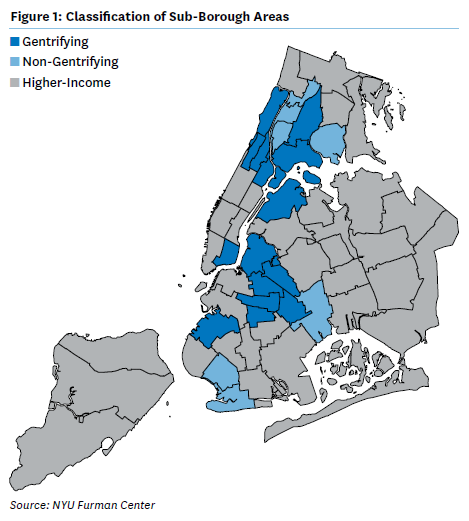Read in ‘The New York Nobody Knows’ (2013) of William Helmreich:
On 12 May 2016 Richard Florida wrote an article in Citylab on a new report of the NYU’s Furman Center for Real Estate and Urban Policy on gentrification in the Big Apple. The researchers divided 55 New York City neighborhoods into three categories: gentrifying, non-gentrifying, and higher-income. Gentrification is happening in 15 neighborhoods (27 percent), 7 are non-gentrifying, and 33 neighborhoods are higher-income already since 1990. The gentrifying neighborhoods were all in Upper Manhattan and in Brooklyn (Williamsburg/Greenpoint). Rent increase in Brooklyn is “a whopping 78 percent”, in West-Harlem and the Lower Eastside more than 50 percent, in Morningside Heights 30 percent. Florida: “Gentrification in New York City is the outcome of a series of economic and demographic trends that have transformed the city more broadly – notably, the surge in more educated, affluent, younger, and single people headed back to the city.” Average households income are rising. Young, educated people all seem to concentrate. The population of New York City as a total is rising again too, also in the non-gentrifying and higher-income neighborhoods. So, do gentrifiers displace the poor? No. In reality poor ànd rich, they all have to deal with steeply rising rent burdens.
The article, sent to me by Lars Boering, managing director of World Press Photo, reminded me of the chapter on gentrification in a great book written by William Helmreich. In ‘The New York Nobody Knows’ (2013), this professor of Sociology at the Graduate Center of CUNY, explored the city by walking 6000 miles through its streets, thus reaching out for every corner and alley. His conclusion is: “When all is said and done, gentrification is a complex issue. It has swept through many parts of the city and has been helped along by many interests. It is changing the face of New York and will shape its future for decades. By observing it on the ground, it becomes possible to see these complexities from different angles, many of the positive, some not necessarily so.” In the Netherlands people think gentrification is dubious. Dutch opinionmakers better be envious, walk 6000 miles in New York City, or read ‘’The New York Nobody Knows’. There’s reason to be far more positive.

Geef een reactie